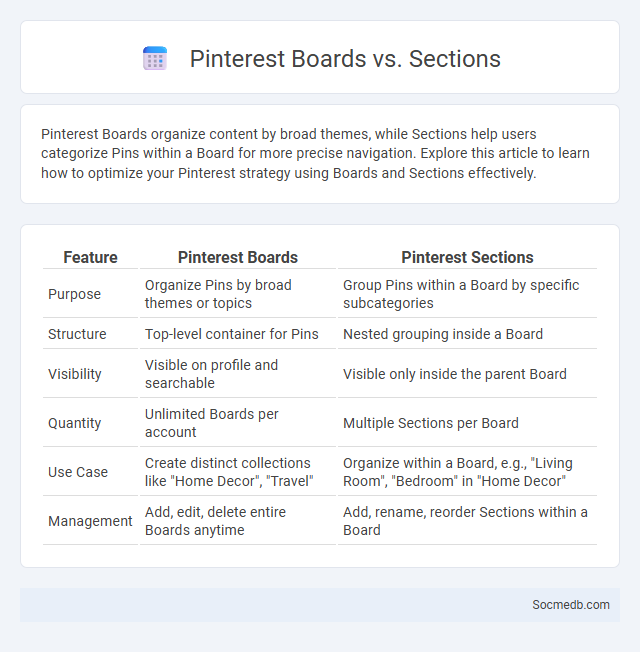
Photo illustration: Pinterest Boards vs Sections
Pinterest Boards organize content by broad themes, while Sections help users categorize Pins within a Board for more precise navigation. Explore this article to learn how to optimize your Pinterest strategy using Boards and Sections effectively.
Table of Comparison
| Feature | Pinterest Boards | Pinterest Sections |
|---|---|---|
| Purpose | Organize Pins by broad themes or topics | Group Pins within a Board by specific subcategories |
| Structure | Top-level container for Pins | Nested grouping inside a Board |
| Visibility | Visible on profile and searchable | Visible only inside the parent Board |
| Quantity | Unlimited Boards per account | Multiple Sections per Board |
| Use Case | Create distinct collections like "Home Decor", "Travel" | Organize within a Board, e.g., "Living Room", "Bedroom" in "Home Decor" |
| Management | Add, edit, delete entire Boards anytime | Add, rename, reorder Sections within a Board |
Understanding Pinterest Boards: Core Concepts
Pinterest boards organize visual content around specific themes, allowing users to curate and discover ideas efficiently. Each board acts as a digital scrapbook where you can save pins related to your interests, enhancing content categorization and retrieval. Understanding how to create and optimize boards improves your ability to engage with targeted audiences and boost your profile's visibility on Pinterest.
Demystifying Sections Within Pinterest Boards
Pinterest boards are organized into sections that help users categorize and streamline their content, making it easier to navigate specific themes or project ideas. Each section serves as a subfolder within a board, allowing for targeted pin collection that enhances content discovery and user engagement. Understanding the use of sections optimizes Pinterest's visual search capabilities and improves overall content management for brands and individuals.
Defining Search Intent on Pinterest
Defining search intent on Pinterest involves understanding whether users are looking for inspiration, information, or ready-to-purchase items based on their queries. Your content should align with these intentions by targeting keywords that match discovery, consideration, or transactional stages. Optimizing Pins with clear titles, descriptions, and relevant hashtags increases visibility and engagement by directly answering user intent.
Boards vs Sections: Key Differences Explained
Boards on social media serve as primary organizational tools, grouping related content or ideas under a single theme, while sections act as subcategories within these boards to further refine and categorize posts for easier navigation. Boards help users curate broad topics such as travel or fashion, whereas sections allow for more detailed segmentation, like destinations within travel or seasonal trends in fashion. This hierarchical structure improves content discovery and user engagement by offering both general overviews and specific interests.
How Search Intent Influences Pinterest Content
Search intent directly shapes Pinterest content by guiding the creation of pins that align with users' goals, such as inspiration, education, or shopping. Keywords reflecting navigational, informational, or transactional intents help optimize pin visibility and engagement. Understanding search intent enhances targeting strategies, driving higher click-through rates and conversions on Pinterest's visual search platform.
Organizing Content: Boards or Sections?
Organizing content on social media using boards or sections enhances user experience by categorizing posts into easily navigable groups, allowing followers to find relevant information quickly. Boards typically serve broader themes, while sections break down content into more specific subcategories, making your profile appear structured and professional. When you optimize your layout effectively, your audience engages more deeply, boosting visibility and overall interaction.
Optimizing Boards and Sections for Search
Optimizing boards and sections on social media platforms like Pinterest involves using targeted keywords in titles and descriptions to enhance search visibility. Incorporating relevant hashtags and detailed, clear categorizations allows algorithms to better index content, driving organic traffic. Properly structured boards and sections improve user experience and increase the likelihood of engagement and follow-through actions.
Aligning Pinterest Strategy with User Search Intent
Optimizing Pinterest strategy involves analyzing user search intent to tailor pin content that matches specific queries and interests, enhancing engagement and click-through rates. Incorporating keyword-rich descriptions and relevant hashtags aligned with popular search terms increases the visibility of pins in both Pinterest and external search engines. Focusing on intent-driven boards and ensuring a clear call-to-action drives targeted traffic, maximizing the platform's potential for brand growth and customer acquisition.
Best Practices for Board and Section Creation
Creating effective boards and sections on social media optimizes content organization and user engagement. Use clear, keyword-rich titles for boards to enhance discoverability, and group related pins into thematic sections to improve navigation and viewer retention. Consistently update and analyze performance metrics of boards and sections to refine strategy and boost audience interaction.
Maximizing Engagement Through Intent-Driven Organization
Maximizing social media engagement requires an intent-driven organization that aligns content with user motivations and platform algorithms to boost visibility and interaction. Your strategy should segment audiences based on specific intents, such as information-seeking, entertainment, or purchasing decisions, to deliver highly relevant posts. Leveraging data analytics to track user behavior and preferences enhances content personalization, resulting in stronger connections and higher engagement rates.
 socmedb.com
socmedb.com